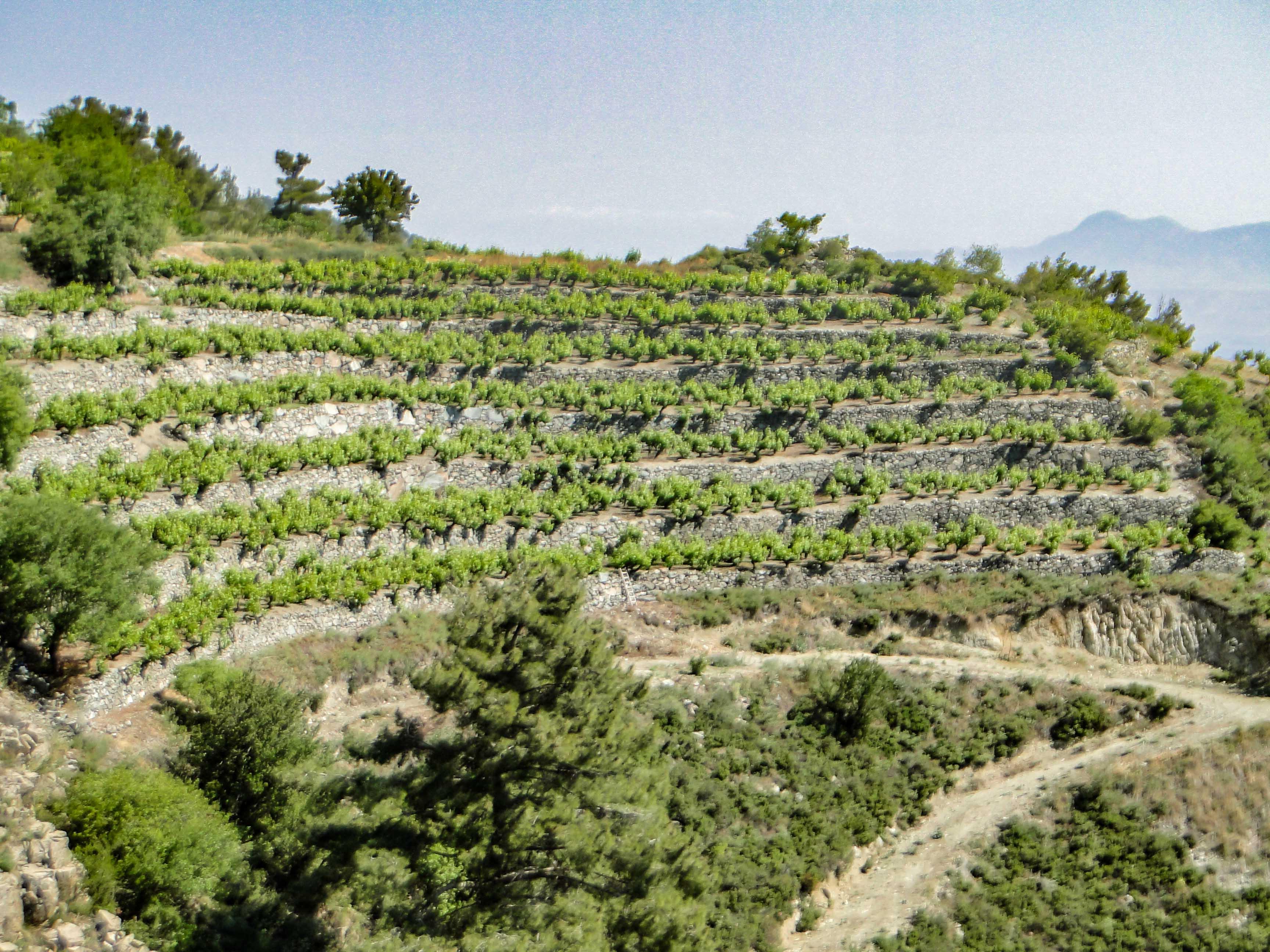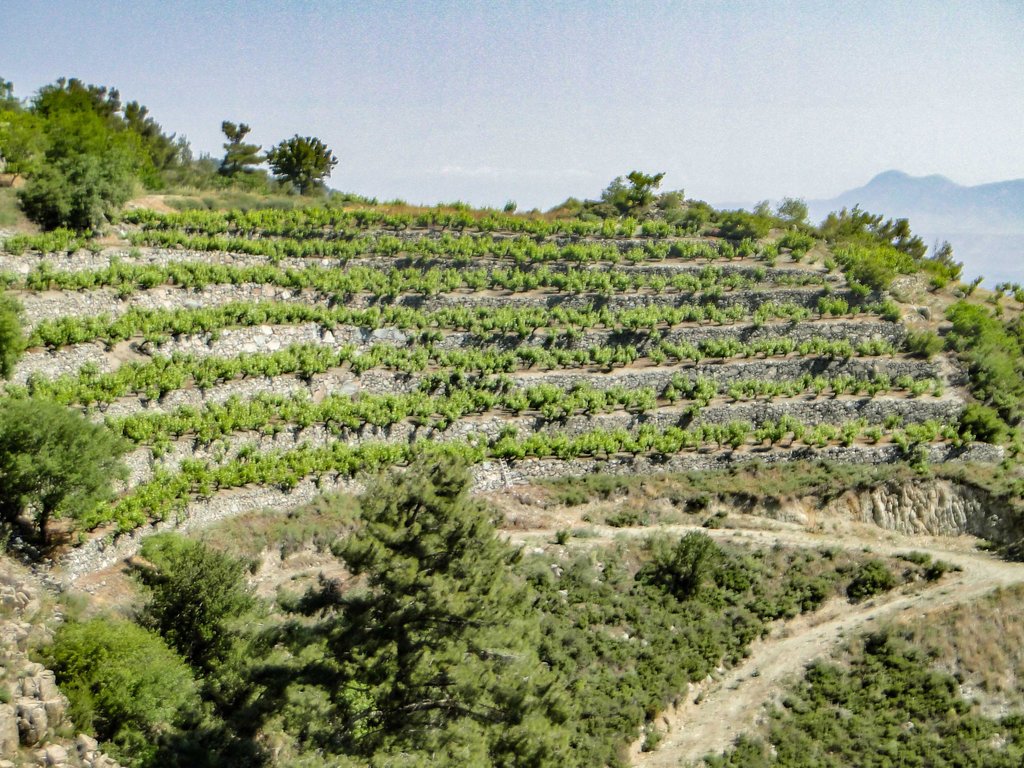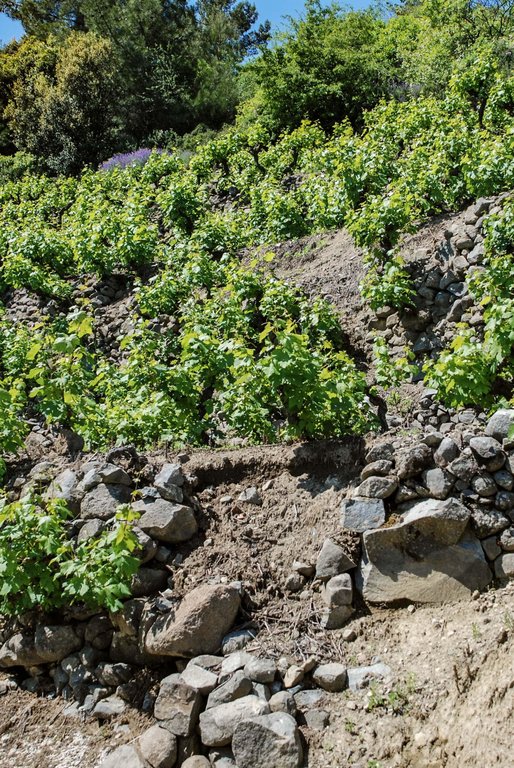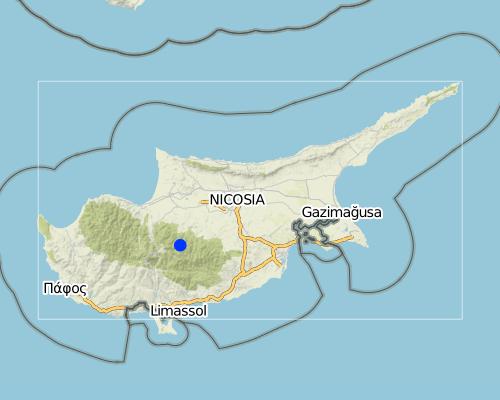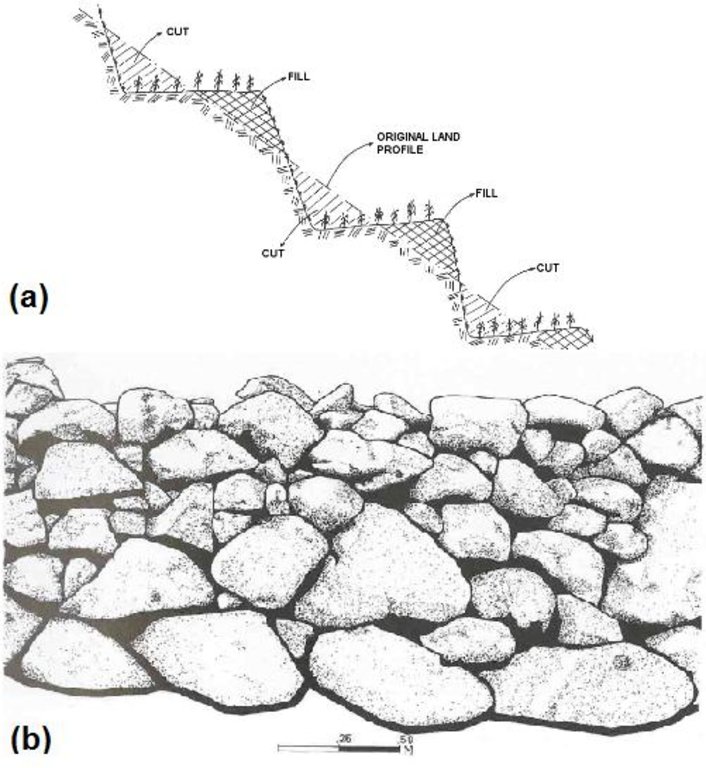Agricultural terraces with dry-stone walls [Cyprus]
- Creation:
- Update:
- Compiler: Christos Zoumides
- Editor: –
- Reviewer: Deborah Niggli
Γεωργικές αναβαθμίδες με τοίχους ξερολιθιάς (Greek)
technologies_1702 - Cyprus
View sections
Expand all Collapse all1. General information
1.2 Contact details of resource persons and institutions involved in the assessment and documentation of the Technology
SLM specialist:
Bruggeman Adriana
a.bruggeman@cyi.ac.cy
The Cyprus Institute
Cyprus
SLM specialist:
Camera Corrado
c.camera@cyi.ac.cy
The Cyprus Insitute
Cyprus
Name of project which facilitated the documentation/ evaluation of the Technology (if relevant)
Preventing and Remediating degradation of soils in Europe through Land Care (EU-RECARE )Name of the institution(s) which facilitated the documentation/ evaluation of the Technology (if relevant)
The Cyprus Institute (The Cyprus Institute) - Cyprus1.3 Conditions regarding the use of data documented through WOCAT
When were the data compiled (in the field)?
01/09/2015
The compiler and key resource person(s) accept the conditions regarding the use of data documented through WOCAT:
Ja
1.4 Declaration on sustainability of the described Technology
Is the Technology described here problematic with regard to land degradation, so that it cannot be declared a sustainable land management technology?
Nee
1.5 Reference to Questionnaire(s) on SLM Approaches
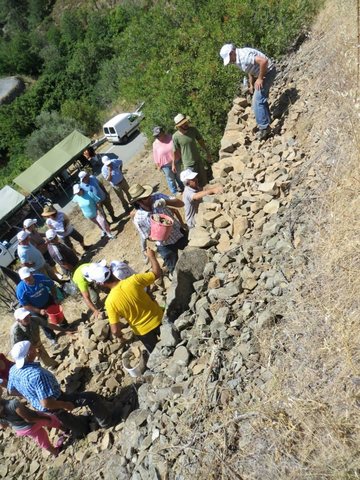
Community-based maintenance and rehabilitation of agricultural terraces in … [Cyprus]
Maintenance and rehabilitation of traditional dry-stone terrace walls for agricultural use, through science-society cooperation, community engagement and motivation, and assistance to land users.
- Compiler: Christos Zoumides
2. Description of the SLM Technology
2.1 Short description of the Technology
Definition of the Technology:
Dry-stone terraces built to create agricultural land, minimise soil erosion and retain soil moisture on steep mountain slopes.
2.2 Detailed description of the Technology
Description:
Dry-stone terraces consist of a series of nearly levelled platforms built along contour lines at suitable intervals. These structures characterise a large part of the landscape in Cyprus, and especially in communities around Troodos Mountains where large areas have been converted to agricultural terraces. The typical terraces found in the study-area are narrow (1-3 m) to medium-base (3-6 m) bench terraces, constructed by cutting and filling in slopes between 20-40%. The terraces are supported by walls, whereby stone is the only construction material without any binding mortar.
Terracing is one of the oldest means of cultivating slopes while saving soil and water. Due to the steep terrain of Troodos Mountains, the establishment of terraces acts as sediment trap storing the washed-off soil material within the slope. In general, terraces were created to stop or reduce the degrading effect of soil erosion by intercepting and controlling the surface run-off velocity and by facilitating its slower infiltration. In such a way, the sediment that accumulates behind the terraces has created suitable land for farming. In addition, the construction of dry-stone walls serves a dual purpose: to clear the land from large rock and stones, and to enhance the stability of the bench terraces against loss of top-soil. This is a type of technology that was very much used in the past and seen today as an important cultural landscape and heritage for these communities.
The construction of dry-stone walls was usually completed by the family who owned the field. Men undertook the building while the rest of the family carried the stones; assistance was also offered by relatives and friends of the family. First, the topography, the height and shape of the terrace is evaluated. Using a fuse, the craftsman shapes a straight line which would follow while building the wall. The foundations are created by excavating a pit of ~0.3-0.5 m, depending on the type of soils and the size of the wall; fuse, pick, mattock and shovel are the typical tools used. The pit is filled with large, irregular-shaped stones.
The stones are used in their natural shape for the construction of the walls without any processing. They are separated according to their shape, size and texture. The stones usually come from the cleaning of fields which will be cultivated or from a small-scale quarrying of the mountain slope using pick and lever. Large and irregular stones are used for the foundations, and the more regular ones for the construction of walls. The smaller stones are placed in between the large stones as the linchpin, to provide better stability to the structure.
The wall follows the land inclination and is laid over the foundation. Large stones are placed on the lower courses of the wall and on the exterior side. The stones are placed by hand one over the other, while smaller stones and rubbles are put between them in order to achieve more stability and better positioning; the stones cross both vertically and horizontally in order to avoid the creation of columns which will make the structure less stable. The wall is built lengthwise following the foundations and it reclines inwards; declination from the foundations does not exceed 5%. The back side of the wall is filled-up with more irregular stones which are not suitable to be placed on the front side. The filling connects the wall with the soil and stabilises the structure, and allows the drainage of water that is collected from the terrace and is discharged through the stones of the wall.
Terrace farming of grapes, nut and fruit trees, along with natural (mainly sclerophylous) vegetation constitute the predominant land uses in this area. The total population in the eight mountain communities of Peristerona Watershed has decreased by more than 50% over the past 30 years. The depopulation of mountain communities is associated with the urbanisation trends and the high farming costs which led to the gradual reduction of agricultural activities in the area. These socio-economic attributes form the main constraining factors for soil conservation. Thus, although terraces have a particularly beneficial effect in maintaining the productive capacity of soils in these communities, the significant changes in the socio-economic structure of the agricultural population over the last decades and the high maintenance and labour required, has led farmers to gradually abandon terrace farming. Consequently, many of the mountain terraces are no longer cultivated and dry stone walls are not maintained, causing sometimes a domino effect of collapsing terraces.
2.3 Photos of the Technology
2.5 Country/ region/ locations where the Technology has been applied and which are covered by this assessment
Country:
Cyprus
Region/ State/ Province:
Nicosia
Further specification of location:
Northeast Pitsilia
Map
×2.6 Date of implementation
If precise year is not known, indicate approximate date:
- more than 50 years ago (traditional)
2.7 Introduction of the Technology
Specify how the Technology was introduced:
- as part of a traditional system (> 50 years)
Comments (type of project, etc.):
Dry-stone terracing has been practice for centuries in Cyprus and in the study area. The rehabilitation of dry-stone terraces through community-based activities has been introduced in 2015 by the RECARE project case-study team and the local communities.
3. Classification of the SLM Technology
3.1 Main purpose(s) of the Technology
- reduce, prevent, restore land degradation
3.2 Current land use type(s) where the Technology is applied

Cropland
- Tree and shrub cropping
Comments:
Major land use problems (compiler’s opinion): Soil erosion by water from degraded and collapsing dry-stone terraces.
Loss of productive capacity.
Major land use problems (land users’ perception): Gradual collapse of dry-stone walls.
Root rot and yield failure as a result of water-logging which is linked to poor drainage in terraced fields.
3.3 Further information about land use
Water supply for the land on which the Technology is applied:
- rainfed
Number of growing seasons per year:
- 1
Specify:
Longest growing period in days: 240, Longest growing period from month to month: Mid March to early November (grapevines)
3.4 SLM group to which the Technology belongs
- cross-slope measure
3.5 Spread of the Technology
Specify the spread of the Technology:
- evenly spread over an area
If the Technology is evenly spread over an area, indicate approximate area covered:
- 10-100 km2
Comments:
Total area covered by the SLM Technology is 30.9 m2.
Dry-stone terraces characterise a large part of the landscape in Cyprus, and especially in communities around Troodos Mountains. There is a large variety of dry-stone terraces on the island, according to the morphology of each area and the accessibility to raw materials. The information reported here refer to the mountain communities in Northeast Pitsilia and particularly to the Peristerona watershed upstream communities (RECARE project case-study site).
3.6 SLM measures comprising the Technology

structural measures
- S1: Terraces
Comments:
Main measures: structural measures
3.7 Main types of land degradation addressed by the Technology

soil erosion by water
- Wt: loss of topsoil/ surface erosion
- Wo: offsite degradation effects
Comments:
Main type of degradation addressed: Wt: loss of topsoil / surface erosion
Secondary types of degradation addressed: Wo: offsite degradation effects
Main causes of degradation: other human induced causes (specify) (Gradual abandonment of mountain agriculture), other natural causes (avalanches, volcanic eruptions, mud flows, highly susceptible natural resources, extreme topography, etc.) specify (Steep mountain terrain)
Secondary causes of degradation: land tenure (Small, fractured agricultural plots), governance / institutional (Lack of institutions for terrace maintenance)
3.8 Prevention, reduction, or restoration of land degradation
Specify the goal of the Technology with regard to land degradation:
- prevent land degradation
- restore/ rehabilitate severely degraded land
4. Technical specifications, implementation activities, inputs, and costs
4.1 Technical drawing of the Technology
4.2 Technical specifications/ explanations of technical drawing
(a) The typical terraces found in the study-area are narrow (1-3 m) to medium-base (3-6 m) bench terraces, constructed by cutting and filling in slopes between 20-40%. The height of terraces range between 0.75 to 2 meters, depending on the steepness and the morphology of each slope.
(b) The terraces are supported by walls, whereby stone - typically volcanic rock - is the only construction material without any binding mortar. Large and irregular stones are used for the foundations, while the more regular for the construction of walls. The smaller stones are placed in between the large stones as the linchpin, to provide better stability to the structure. The wall is built lengthwise following the foundations and it reclines inwards; declination from the foundations does not exceed 5%. The back side of the wall is filled-up with more irregular stones which are not suitable to be placed on the front side. The filling connects the wall with the soil and stabilises the structure, and allows the drainage of water that is collected from the terrace and is discharged through the stones of the wall.
Northeast Pitsilia, Nicosia
Technical knowledge required for land users: moderate (To maintain dry-stone wall terraces)
Technical knowledge required for Dry-stone artisans (experts builders): high (To reconstruct collapsed terraces)
Main technical functions: reduction of slope angle, sediment retention / trapping, sediment harvesting
Secondary technical functions: increase of infiltration, increase / maintain water stored in soil
Terrace: bench level
Vertical interval between structures (m): 1-2
Spacing between structures (m): 1-15
Construction material (stone): Natural volcanic rock available on the sites (mostly gabbro & diabase)
Lateral gradient along the structure: 0-8%
4.3 General information regarding the calculation of inputs and costs
other/ national currency (specify):
Euro
Indicate exchange rate from USD to local currency (if relevant): 1 USD =:
0.88
Indicate average wage cost of hired labour per day:
72.97
4.4 Establishment activities
| Activity | Type of measure | Timing | |
|---|---|---|---|
| 1. | Land leveling and foundation | Structural | Early autumn or late spring |
| 2. | Collection and transfer of stones | Structural | Early autumn or late spring |
| 3. | Construction of stone-wall | Structural | Early autumn or late spring |
4.5 Costs and inputs needed for establishment
| Specify input | Unit | Quantity | Costs per Unit | Total costs per input | % of costs borne by land users | |
|---|---|---|---|---|---|---|
| Labour | Labour | 4000.0 | 45.6 | 182400.0 | 100.0 | |
| Total costs for establishment of the Technology | 182400.0 | |||||
Comments:
Duration of establishment phase: 83 month(s)
4.6 Maintenance/ recurrent activities
| Activity | Type of measure | Timing/ frequency | |
|---|---|---|---|
| 1. | Repairing collapsed walls | Structural | Early autumn (before onset of rains), only on collapsed walls |
4.7 Costs and inputs needed for maintenance/ recurrent activities (per year)
| Specify input | Unit | Quantity | Costs per Unit | Total costs per input | % of costs borne by land users | |
|---|---|---|---|---|---|---|
| Labour | Labour | 200.0 | 9.12 | 1824.0 | 100.0 | |
| Total costs for maintenance of the Technology | 1824.0 | |||||
Comments:
Machinery/ tools: Wedge, hammer, pick, hoe and bucket are the typical tools used for by stone builders for the construction and maintenance of dry-stone terraces.
The costs estimates are averages and were calculated for the length of terrace structures, i.e. per running meter of terrace walls. The average height of dry-stone walls is 1.5 meter and it takes approximately 5 hours/meter for a builder to fully construct it. This includes 1 hour/meter for land levelling and foundation, 1 hour/meter for the collection and transfer of the necessary stones and 3 hours/meter for building the wall. Stones are abundant in the area; builders do not charge for the stones but for the time required to collect and transfer. Also, each builder has its own tools (i.e. wedge, hammer, pick, hoe and bucket). Terrace builders charge 8 €/hour (or 9.12 $/hour). On average, there are approximately 4000 running meters of terrace walls per hectare. The above information is used to convert the construction cost per hectare.
Maintenance activities include reconstruction of the terrace walls, only in case of collapsing. The reconstruction takes 1 hour/meter. For the annual maintenance estimates, it is assumed that 200 out of 4000 meters of terrace walls per hectare (or 5%) will require maintenance. In other words, a newly constructed wall will be maintained once every 20 years, on average.
4.8 Most important factors affecting the costs
Describe the most determinate factors affecting the costs:
The principal input cost for the construction and maintenance of terraces is manual labour. There are only few dry-stone builders in the area.
5. Natural and human environment
5.1 Climate
Annual rainfall
- < 250 mm
- 251-500 mm
- 501-750 mm
- 751-1,000 mm
- 1,001-1,500 mm
- 1,501-2,000 mm
- 2,001-3,000 mm
- 3,001-4,000 mm
- > 4,000 mm
Specifications/ comments on rainfall:
500-750mm: Seasonal rainfall (October to May) - Peristerona watershed upstream
250-500mm: Seasonal rainfall (October to May) - Peristerona watershed downstream
Agro-climatic zone
- sub-humid
- semi-arid
Thermal climate class: subtropics. Below 1000m a.s.l.
Thermal climate class: temperate. Above 1000m a.s.l.
5.2 Topography
Slopes on average:
- flat (0-2%)
- gentle (3-5%)
- moderate (6-10%)
- rolling (11-15%)
- hilly (16-30%)
- steep (31-60%)
- very steep (>60%)
Landforms:
- plateau/plains
- ridges
- mountain slopes
- hill slopes
- footslopes
- valley floors
Altitudinal zone:
- 0-100 m a.s.l.
- 101-500 m a.s.l.
- 501-1,000 m a.s.l.
- 1,001-1,500 m a.s.l.
- 1,501-2,000 m a.s.l.
- 2,001-2,500 m a.s.l.
- 2,501-3,000 m a.s.l.
- 3,001-4,000 m a.s.l.
- > 4,000 m a.s.l.
Indicate if the Technology is specifically applied in:
- not relevant
5.3 Soils
Soil depth on average:
- very shallow (0-20 cm)
- shallow (21-50 cm)
- moderately deep (51-80 cm)
- deep (81-120 cm)
- very deep (> 120 cm)
Soil texture (topsoil):
- coarse/ light (sandy)
- medium (loamy, silty)
Topsoil organic matter:
- medium (1-3%)
- low (<1%)
5.4 Water availability and quality
Ground water table:
> 50 m
Availability of surface water:
medium
Water quality (untreated):
good drinking water
5.5 Biodiversity
Species diversity:
- medium
5.6 Characteristics of land users applying the Technology
Sedentary or nomadic:
- Sedentary
Market orientation of production system:
- mixed (subsistence/ commercial
Off-farm income:
- 10-50% of all income
Relative level of wealth:
- average
Individuals or groups:
- individual/ household
Level of mechanization:
- manual work
- mechanized/ motorized
Gender:
- women
- men
Indicate other relevant characteristics of the land users:
Land users applying the Technology are mainly common / average land users
Population density: 10-50 persons/km2
Annual population growth: negative; 4%
100% of the land users are average wealthy.
Off-farm income specification: Farming is a part-time activity for most land users in the area.
5.7 Average area of land owned or leased by land users applying the Technology
- < 0.5 ha
- 0.5-1 ha
- 1-2 ha
- 2-5 ha
- 5-15 ha
- 15-50 ha
- 50-100 ha
- 100-500 ha
- 500-1,000 ha
- 1,000-10,000 ha
- > 10,000 ha
Is this considered small-, medium- or large-scale (referring to local context)?
- small-scale
Comments:
The average for Cyprus is 3.4 ha/holding
5.8 Land ownership, land use rights, and water use rights
Land ownership:
- individual, titled
Land use rights:
- individual
Comments:
Agricultural land is privately owned
5.9 Access to services and infrastructure
health:
- poor
- moderate
- good
education:
- poor
- moderate
- good
technical assistance:
- poor
- moderate
- good
employment (e.g. off-farm):
- poor
- moderate
- good
markets:
- poor
- moderate
- good
energy:
- poor
- moderate
- good
roads and transport:
- poor
- moderate
- good
drinking water and sanitation:
- poor
- moderate
- good
financial services:
- poor
- moderate
- good
6. Impacts and concluding statements
6.1 On-site impacts the Technology has shown
Socio-economic impacts
Production
crop production
Comments/ specify:
Terraces create agricultural land for crop production in slopes. However, the establishment of terraces does not imply increased crop yield.
production area
Comments/ specify:
Without terraces on mountain slopes, crop farming would have been almost impossible
Water availability and quality
demand for irrigation water
Comments/ specify:
Well constructed and maintained terraces improve water drainage and retain soil moisture.
Income and costs
expenses on agricultural inputs
Comments/ specify:
More costly to grown on mountain terraces than in the plains. Also, maintenance of collapsed terrace walls is costly.
farm income
Comments/ specify:
Farming in the study-site is practiced almost exclusively on terraces; well maintained terraces can increase farm income.
workload
Comments/ specify:
Maintenance of collapsed terrace walls requires manual labour
Socio-cultural impacts
food security/ self-sufficiency
Comments/ specify:
Partly for those land users that still practice mountain terrace farming.
cultural opportunities
Comments/ specify:
When terraces are maintained/rehabilitated through community-based activities.
recreational opportunities
Comments/ specify:
When terraces are maintained/rehabilitated through community-based activities.
community institutions
Comments/ specify:
When terraces are maintained/rehabilitated through community-based activities.
SLM/ land degradation knowledge
Comments/ specify:
Dry-stone terracing is the typical soil conservation technology in the study-site
conflict mitigation
Contribution to human well-being
Comments/ specify:
Terraced landscapes in the Troodos mountains represent a longstanding tradition of self-sustained communities. In the past, terrace farming was a main activity and has contributed to the livelihoods and well-being of these communities. Nowadays, terrace farming is still practiced by much fewer land users, mainly on part-time basis.
Ecological impacts
Water cycle/ runoff
harvesting/ collection of water
Comments/ specify:
One of the main functions of terraces.
surface runoff
Comments/ specify:
One of the main functions of terraces.
Soil
soil cover
Comments/ specify:
When terraces are maintained
soil loss
Comments/ specify:
One of the main functions of terraces.
Biodiversity: vegetation, animals
habitat diversity
Comments/ specify:
Dry-stone terraces create biodiversity habitats, especially for reptiles and arthropods
Climate and disaster risk reduction
fire risk
Comments/ specify:
Well maintained terraces have less weeds than abandoned terraces, thus reducing the fire risk
Other ecological impacts
Abandoned or poorly maintained terraces can result in increased erosion, e.g. through the collapsing
6.2 Off-site impacts the Technology has shown
downstream flooding
Comments/ specify:
Upstream terraces can reduce to a certain extent reduced downstream flooding
downstream siltation
Comments/ specify:
Upstream terraces can reduce to a certain extent downstream siltation
damage on public/ private infrastructure
Comments/ specify:
Well maintain terraces reduce damage (erosion) on public (e.g. roads) and private (e.g. neighbours fields) infrastructure
6.3 Exposure and sensitivity of the Technology to gradual climate change and climate-related extremes/ disasters (as perceived by land users)
Gradual climate change
Gradual climate change
| Season | Type of climatic change/ extreme | How does the Technology cope with it? | |
|---|---|---|---|
| annual temperature | increase | well |
Climate-related extremes (disasters)
Meteorological disasters
| How does the Technology cope with it? | |
|---|---|
| local rainstorm | not well |
| local windstorm | not known |
Climatological disasters
| How does the Technology cope with it? | |
|---|---|
| drought | well |
Hydrological disasters
| How does the Technology cope with it? | |
|---|---|
| general (river) flood | not well |
Other climate-related consequences
Other climate-related consequences
| How does the Technology cope with it? | |
|---|---|
| reduced growing period | well |
6.4 Cost-benefit analysis
How do the benefits compare with the establishment costs (from land users’ perspective)?
Short-term returns:
negative
Long-term returns:
positive
How do the benefits compare with the maintenance/ recurrent costs (from land users' perspective)?
Short-term returns:
slightly negative
Long-term returns:
positive
6.5 Adoption of the Technology
- more than 50%
If available, quantify (no. of households and/ or area covered):
90% of the land user families and 8% of the stated area
Of all those who have adopted the Technology, how many have did so spontaneously, i.e. without receiving any material incentives/ payments?
- 10-50%
Comments:
10% of land user families have adopted the Technology without any external material support
90% of land user families have adopted the Technology with external material support
Comments on acceptance with external material support: The majority of existing terraces in the area were subsidized.
There is a little trend towards spontaneous adoption of the Technology
Comments on adoption trend: There are very few farmers that maintain existing terraces or construct new ones.
6.7 Strengths/ advantages/ opportunities of the Technology
| Strengths/ advantages/ opportunities in the compiler’s or other key resource person’s view |
|---|
|
Indigenous technology of great agro-ecological value, adapted to local conditions. |
|
Soil maintained on steep mountain slopes, thus reducing soil loss due to water erosion. |
|
Terraces maintain the productive capacity of soils on steep slopes. |
|
Water retention and longer storage of soil moisture, thus improving water use efficiency. |
|
Terraces are part of cultural landscapes and heritage |
6.8 Weaknesses/ disadvantages/ risks of the Technology and ways of overcoming them
| Weaknesses/ disadvantages/ risks in the compiler’s or other key resource person’s view | How can they be overcome? |
|---|---|
| Maintenance of dry-stone wall terraces is costly and labour intensive. | Promote community-based terrace maintenance and utilise available community/subsidy funds for small cash compensation to terrace experts. |
| Terrace maintenance requires expert knowledge. | Motivate the younger generation to engage in part-time terrace farming. |
| Aging of the dry-stone experts. | Train young land users/owners on dry-stone terracing. |
| Technology does not lend itself to mechanisation. | Not possible to overcome. |
7. References and links
7.1 Methods/ sources of information
- interviews with land users
7.2 References to available publications
Title, author, year, ISBN:
FAO, 2000. Manual on integrated soil management and conservation practices. FAO Land and Water Bulletin 8, Rome, Italy: 230 pp.TPH, 2007. Dry stone constructions of Cyprus. PIO, Nicosia.
Links and modules
Expand all Collapse allLinks

Community-based maintenance and rehabilitation of agricultural terraces in … [Cyprus]
Maintenance and rehabilitation of traditional dry-stone terrace walls for agricultural use, through science-society cooperation, community engagement and motivation, and assistance to land users.
- Compiler: Christos Zoumides
Modules
No modules


